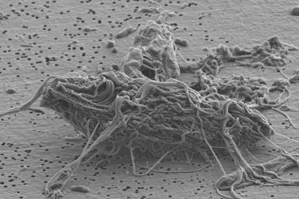Superbugs

 What you see to the left may look like a giant dehydryated cocroach overgrown with some form of alien kudzoo, but in fact it’s a microbe only a few microns long. That’s a fraction of the thickness of a human hair.
What you see to the left may look like a giant dehydryated cocroach overgrown with some form of alien kudzoo, but in fact it’s a microbe only a few microns long. That’s a fraction of the thickness of a human hair.
Slava Epstein of the the department of biology found this little guy in the Cariaco Basin in the Caribbean off the coast of Venezuela. Epstein and his team work to reveal the genetics of this and other so-called “marine cilliates” to find out what makes them so good at living on the oxygen-poor sea floor.
Cilliates are a type of microbe, which, according to Epstein, are very well studied in the microbial research world. The cilliate shown here belongs to a group that Epstein believes is an entirely new class. This is important because it adds to the ever expanding biodiversity of the “microbiome,” which is what scientists call the collective gazillion (that’s an estimate on my part) microbes on the planet.
Microbes are the largest and most diverse population of species around and understanding them can lead to insights as far reaching as disease, evolution, and life on mars — to name a few.
One of the overarching goals of the Epstein lab is to begin classifying the extent of biodiversity present in the microbiome. The ocean floor is just a beginning.
Photo Courtesy of William Orsi, 2009





